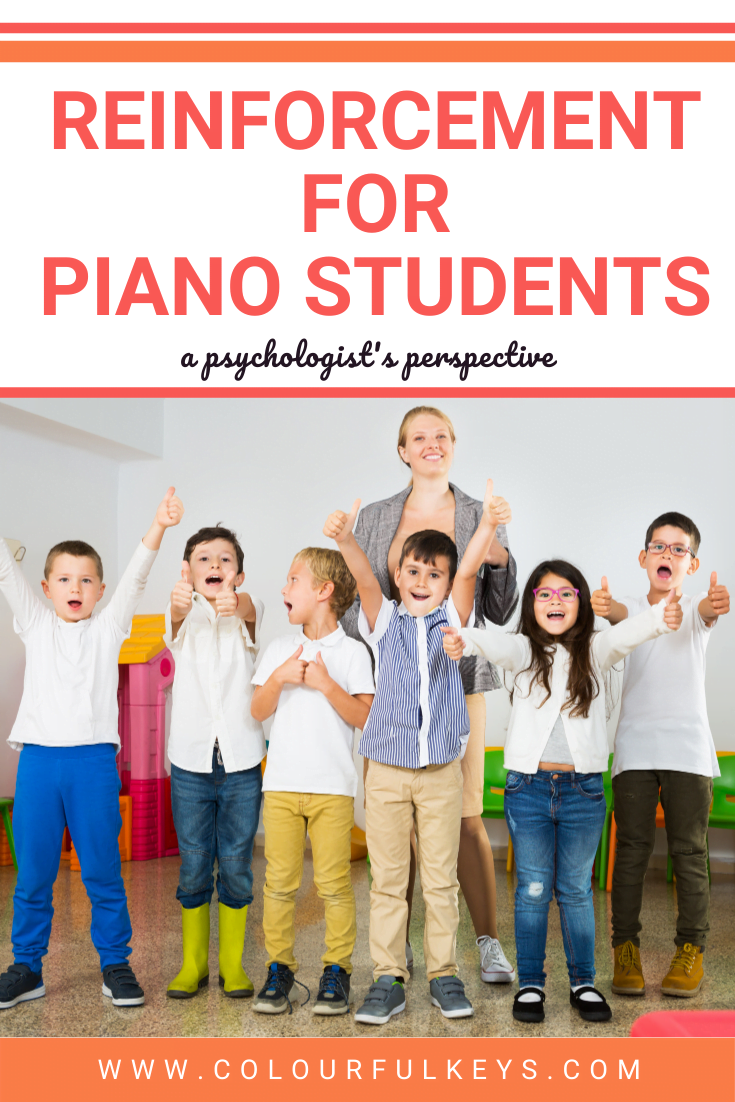This blog post about reinforcement for piano students was written by Catherine A. Perz, Ph. D. Dr. Perz is an Associate Professor of Psychology at the University of Houston-Victoria in Victoria, Texas USA and a licensed Clinical Psychologist. She studies processes of behaviour change, and is currently working on research into the mental health impacts of the COVID-19 pandemic.
Positive reinforcement is an important topic in all of my classes (and in most psychology classes.) I like to teach it because it gives practical tools that can be used daily in many situations.

Used correctly, positive reinforcement can improve relationships, change your habits, reach goals and enhance your own life. Long after my students finish a class, I hope they have the ability to use these tools.
The central idea behind reinforcement is this:
Behaviour is a function of its consequences.
In other words, we tend to do what we do because of what happens after we do it. And we can influence our students’ behaviours by changing what happens after they do that behaviour.
Positive reinforcement means giving a reward or some positive consequence once the student does something well – which makes it more likely they’ll repeat the desired behaviour. What you reinforce will get repeated.
Most teachers use positive reinforcement frequently with their piano students. I don’t have to teach you to praise your students, or – for some of you – to give small rewards after a good performance. But I may have some tips for you from a psychologist’s perspective so you can use positive reinforcement most effectively.
#1: What to Reinforce
To begin with, be sure that you are providing reinforcement for the right things.
Reinforce behaviours which you actually want to be repeated! We often accidentally reinforce the wrong things.
My cat Benny likes to eat things such as paper and fabric. Obviously this is not good for him. The first few times I saw him do it, I unfortunately responded by freaking out a little, dropping whatever I was doing, giving him my total focus and pleading with him not to do that while I petted him and peered in his mouth.
Attention is rewarding for both people and animals. So basically when he ate a hole in a blanket, I gave him a lot of attention which rewarded him for doing it.
Unfortunately, he did it again.

Reinforcing the wrong thing can cause problems to get worse. Don’t be like me – reinforce only the right things.
#2: Choose Reinforcers Wisely
What is rewarding for one person is not for another.
Small items such as toys, books or pictures can be rewarding for children. Class grades are reinforcing for university students.
But interpersonal reinforcement is very powerful for most of us. Praise, smiles and hugs go a long way.
As I mentioned, attention is very rewarding for people (and cats, etc.) Most teachers use attention and praise pretty often, to good effect.
#3: Ground Rules for Praise
Praise is very powerful. But there are ground rules you should follow:
Be Sincere
Don’t praise anything you don’t actually like, don’t praise someone for something they don’t actually do, and don’t fake it.
If you can’t honestly say something good, don’t say it. Insincerity is often more apparent than we think it is.
Find something else to praise.
Don’t Spoil It
Be sure not to spoil praise by including even subtle criticism or disappointment. Spoiled praise takes a positive reinforcer and turns it into a punishment. It’s better to say nothing than to spoil your praise of something.
Here are examples of spoiled praise:
- You did that so well! Why can’t you always do it like that?
- You really paid attention today; normally you don’t.
- I don’t know why you didn’t do that yesterday when you could do it so well today.
- You did that really well! I sure hope you don’t forget it by next week…
Be Brief and Specific
Don’t overpraise, and don’t gush. Brief and sincere praise is better.

Don’t praise robotically or using the same phrases every time. Praise does not have the same effect if it is given in a repetitive or emotionless way.
#4: Timing
Give a reward or praise as soon as you can. Immediate praise is best.
Reinforcers are most effective right after the behaviour is shown.
Praise hours or days later is still pleasant and useful, but it probably will not have as strong an effect on the thing you are praising.
#5: Consistency and Frequency
At first, be consistent in using reinforcement. Reward a desired behaviour right away. Don’t delay, and be sure you reward it every time. This helps get the behaviour established.
Once the behaviour is established, start using the positive reinforcement with music students less frequently and less predictably.
People can become used to a reinforcer and get bored with it if it’s used every time. In other words, once the student learns a behaviour, don’t praise it every single time.
#6: The Power of Omission
If you can’t praise, sometimes it’s better to say nothing.
Sometimes we forget the usefulness of ignoring those behaviours we don’t like.
I don’t mean you should pretend you don’t care about what the student does, or pretend they’re not there. Rather, I mean “omission” – or not reinforcing.
If someone does something you don’t like, or don’t want them to repeat, just don’t respond. Remember, attention is powerful! Don’t give attention to behaviours you don’t like.
This is a more effective response to undesirable behaviours than is punishment, which has so many side effects.
Punishment – even if it’s just a verbal reprimand – does not work as well as positive reinforcement, and it can have negative effects on relationships. Learn to omit reinforcement without showing any positive or negative response.
Bite your tongue. Be a tree. Say nothing. Wait for the student to show a useful behaviour instead, then praise that.
Ignoring may or may not change the behaviour you see, but it can keep you from reinforcing the wrong thing.
Refine Your Own Style
The topic of operant conditioning with positive reinforcement is one which many psychologists have spent their entire careers researching. But I hope these definitions, tools and tips can help you refine your style and use positive reinforcement effectively with your own piano students.
How do you use positive reinforcement for piano students? We’d love to hear your thoughts in the comments below or on the Vibrant Music Studio Teachers Facebook Group 🙂. And for more ideas on motivating your music students, check out the Motivation & Goals section of Nicola’s Piano Practice page.
